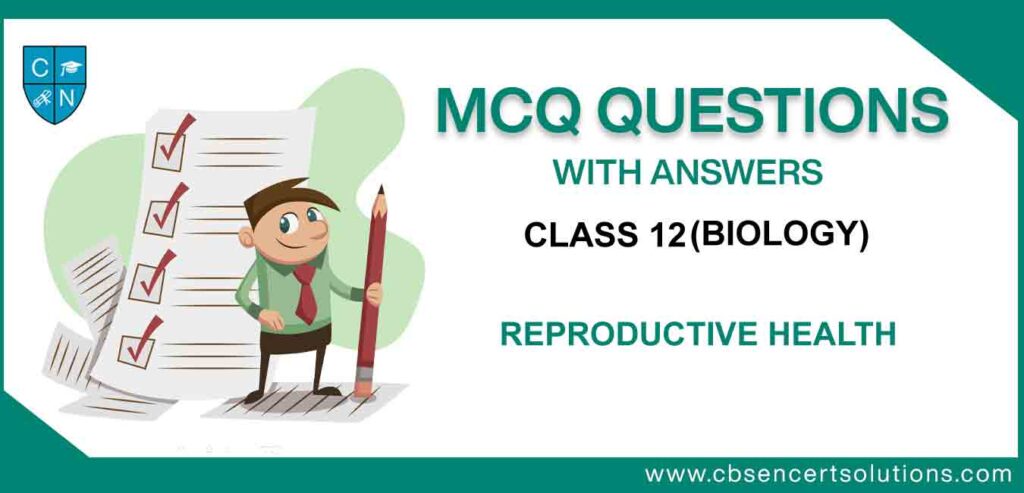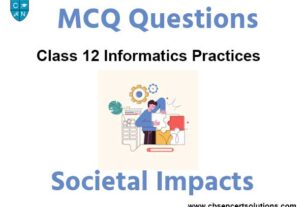Check the below NCERT MCQ Class 12 Biology Chapter 4 Reproductive Health with Answers available with PDF free download. MCQ Questions for Class 12 Biology with Answers were prepared based on the latest syllabus and examination pattern issued by CBSE, NCERT and KVS. Our teachers have provided below Reproductive Health Class 12 Biology MCQs Questions with answers which will help students to revise and get more marks in exams
Reproductive Health Class 12 Biology MCQs Questions with Answers
Refer below for MCQ Class 12 Biology Chapter 4 Reproductive Health with solutions. Solve questions and compare with the answers provided below
Question. Which of the following cannot be detected in a developing fetus by amniocentesis?
(a) Down’s syndrome
(b) Jaundice
(c) Klinefelter’s syndrome
(d) Sex of the fetus
Answer
B
Question. Which of the following is a correct statement?
(a) IUDs once inserted need not be replaced.
(b) IUDs are generally inserted by the user herself.
(c) IUDs increase phagocytosis of sperms in the uterus.
(d) IUDs suppress gametogenesis.
Answer
C
Question. Which of the following is incorrect regarding vasectomy?
(a) No sperm occurs in seminal fluid
(b) No sperm occurs in epididymis
(c) Vasa deferentia is cut and tied
(d) Irreversible sterility
Answer
B
Question. Which of the following is a hormone releasing Intra Uterine Device (IUD)?
(a) Multiload 375
(b) LNG – 20
(c) Cervical cap
(d) Vault
Answer
B
Question. Cu ions released from copper-releasing intra uterinedevices (IUDs)
(a) make uterus unsuitable for implantation
(b) increase phagocytosis of sperms
(c) suppress sperm motility
(d) prevent ovulation.
Answer
C
Question. What is the work of progesterone which is present in oral contraceptive pills?
(a) To inhibit ovulation
(b) To check oogenesis
(c) To check entry of sperms into cervix and to make them inactive
(d) To check sexual behaviour
Answer
A
Question. Medical Termination of Pregnancy (MTP) is considered safe up to how many weeks of pregnancy?
(a) Eight weeks
(b) Twelve weeks
(c) Eighteen weeks
(d) Six weeks
Answer
B
Question. Select the option including all sexually transmitted diseases.
(a) Gonorrhoea, Syphilis, Genital herpes
(b) Gonorrhoea, Malaria, Genital herpes
(c) AIDS, Malaria, Filaria
(d) Cancer, AIDS, Syphilis
Answer
A
Question. Which of the following sexually transmitted diseases is not completely curable?
(a) Chlamydiasis
(b) Gonorrhoea
(c) Genital warts
(d) Genital herpes
Answer
D
Question. Which of the following is not a sexually transmitted disease?
(a) Trichomoniasis
(b) Encephalitis
(c) Syphilis
(d) Acquired Immuno Deficiency Syndrome
Answer
B
Question. In which of the following techniques, the embryos are transferred to assist those females who cannot conceive?
(a) ZIFT and IUT
(b) GIFT and ZIFT
(c) ICSI and ZIFT
(d) GIFT and ICSI
Answer
A
Question. A childless couple can be assisted to have a child through a technique called GIFT. The full form of this technique is
(a) Gamete Internal Fertilisation and Transfer
(b) Germ cell Internal Fallopian Transfer
(c) Gamete Inseminated Fallopian Transfer
(d) Gamete Intra Fallopian Transfer.
Answer
D
Question. Artificial Insemination means
(a) artificial introduction of sperms of a healthy donor into the vagina
(b) introduction of sperms of a healthy donor directly into the ovary
(c) transfer of sperms of a healthy donor to a test tube containing ova
(d) transfer of sperms of husband to a test tube containing ova.
Answer
A
Question. The test-tube baby programme employs which one of the following techniques?
(a) Intra Cytoplasmic Sperm Injection (ICSI)
(b) Intra Uterine Insemination (IUI)
(c) Gamete Intra Fallopian Transfer (GIFT)
(d) Zygote Intra Fallopian Transfer (ZIFT
Answer
D
Question. The test tube baby means
(a) fertilisation and development both in uterus
(b) fertilisation in vitro and then transplantation in uterus
(c) a baby grown in test tube
(d) fertilised and developed embryo in test tube.
Answer
B
Question. The technique called Gamete Intra Fallopian Transfer (GIFT) is recommended for those females
(a) who cannot produce an ovum
(b) who cannot retain the fetus inside uterus
(c) whose cervical canal is too narrow to allow passage for the sperms
(d) who cannot provide suitable environment for fertilisation.
Answer
A
Question. GIFT is
(a) transfer of a sperm in fallopian tube of a female with the help of injections.
(b) transfer of a zygote fertilized in vitro in the fallopian tube of female incapable to conceive.
(c) transfer of an ovum collected from a donor into another females fallopian tube who can’t produce an ovum but can provide a good environment for further development.
(d) embryo is developed in vitro and then transferred into female’s tract
Answer
C
Question. Progestasert and LNG-20 are [2013]
(a) Implants
(b) Copper releasing IUDs
(c) Non-medicated IUDs
(d) Hormone releasing IUDs
Answer
D
Question. The technique called Gamete Intra Fallopian Transfer (GIFT) is recommended for those females
(a) who cannot produce an ovum
(b) who cannot retain the foetus inside uterus
(c) who cannot provide suitable environment for fertilisation
(d) all of these
Answer
A
Question. Intensely lactating mothers do not generally conceive due to the
(a) suppression of gonadotropins
(b) hypersecretion of gonadotropins .
(c) suppression of gametic transport
(d) suppression of fertilisation.
Answer
A
Question. The correct surgical procedure as a contraceptive method is
(a) ovariectomy
(b) hysterectomy
(c) vasectomy
(d) castration.
Answer
C
Question. Causes for increased population growth in india is/are
(a) increase in birth rate
(b) decrease in death rate
(c) lack of education
(d) all of these.
Answer
D
Question. Which of the following is correct regarding HIV, hepatitis B, gonorrhoea, trichomoniasis ?
(a) Trichomoniasis is an STD whereas others are not.
(b) Gonorrhoea is a viral disease whereas others are bacterial.
(c) HIV is a pathogen whereas others are diseases.
(d) Hepatitis B is eradicated completely whereas others are not.
Answer
C
Question. Which of the following STDs are not completely curable ?
(a) Chlamydiasis, gonorrhoea, trichomoniasis
(b) Chancroid syphilis, genital warts
(c) AIDS, syphilis, hepatitis B
(d) AIDS, genital herpes, hepatitis B
Answer
D
Question. On which of the following facts does the method of periodic abstinence is based ?
(a) Ovulation occurs on about the 14th day of menstruation.
(b) Ovum remains alive for about 1-2 days.
(c) Sperms survive for about 3 days.
(d) All of these
Answer
D
Question. IUDs prevent pregnancy by
(a) inhibiting physiological and morphological uterine changes required for implantation.
(b) increasing phagocytosis of spermatozoa within uterus
(c) suppressing motility of sperms as well as their fertilising capacity
(d) all of these.
Answer
D
Question. Which of the following birth control measures can be considered as the safest ?
(a) The rhythm method
(b) The use of physical barriers
(c) Termination of unwanted pregnancy
(d) Sterilisation techniques
Answer
D
Question. Which of the following statements is incorrect regarding the medical termination of pregnancy (MTP) ?
(a) These help in getting rid of unwanted pregnancies.
(b) These help in aborting the pregnancies which may be harmful to either mother of foetus or both.
(c) These contribute in decreasing the human population.
(d) None of these.
Answer
D
Question. A sexually transmitted disease symptomised by the development of chancre on the genitals is caused by the infection of
(a) Treponema pallidum
(b) Neisseria gonorrhoeae
(c) human immunodeficiency virus
(d) hepatitis B virus
Answer
A
Question. Multiload device contains
(a) manganese
(b) iron
(c) copper
(d) calcium
Answer
C
Question. Which of the following is not the characteristic of an ideal contraceptive?
(a)Irreversible
(b) Easily available
(c) User friendly
(d) Effective with least side effects
Answer
A
Question. What is the shape of the growth curve?
(a) S shaped
(b) V shaped
(c) C shaped
(d) J shaped
Answer
A
Question. In IVF technique zygote or early embryo is transferred into
(a) Cervical canal
(b) Uterus
(c) Fallopian tube
(d) Vagina
Answer
C
Question. Which technique is used to detect AIDS?
(a) Northern blot and ELISA
(b) Immunoblot and ELISA
(c) Western blot and ELISA
(d) Southern blot and ELISA
Answer
C
Question. Amniocentesis is a process to:
(a) Determine any disease ¡n the heart
(b) Know about diseases of brain
(c) Determine any hereditary disease in the embryo
(d) All of these
Answer
C
Question. ZIFT is transfer of
(a) zygote into fallopian tube.
(b) a mixture of sperms and ova into the fallopian tube.
(c) a mixture of sperms and ova into the uterus.
(d) embryo into the uterus.
Answer
A
Question.Which among these is not a natural method of birth control?
(a) Coitus intrruptus
(b) Periodic abstinence
(c) Vasectomy
(d) Lactational amenorrhoea
Answer
B
Question. The birth control device not used by women is?
(a) Diaphrame
(b) Oral pill
(c) Nirodh
(d) Copper-T
Answer
C
Question. Surgical methods, also called sterilisation techniques are fool-poof methods be prevent pregnancy. But, it is the last option for many couples, because
(a) it is nearly irreversible.
(b) of lack of sufficient facilities in many parts of the country.
(c) of fear that it will reduce sexual drive.
(d) all of these
Answer
D

We hope you liked MCQ Class 12 Biology Chapter 4 Reproductive Health with answers provided above. Incase you have any questions please post them in the comments section below and our Biology teachers will provide a response.


Thanks a lot